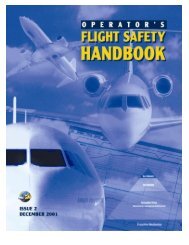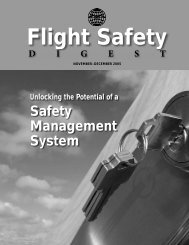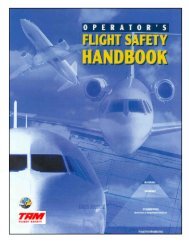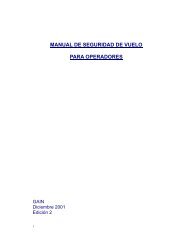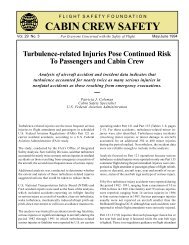Download PDF [10.9 MB] - Flight Safety Foundation
Download PDF [10.9 MB] - Flight Safety Foundation
Download PDF [10.9 MB] - Flight Safety Foundation
Create successful ePaper yourself
Turn your PDF publications into a flip-book with our unique Google optimized e-Paper software.
INBRIEF<br />
Tower Closures<br />
Some 149 airport air traffic control towers in<br />
the United States will close June 15 because<br />
of legislative requirements that the Federal<br />
Aviation Administration (FAA) cut $637 million<br />
from its budget.<br />
The FAA originally had planned to close the<br />
facilities in April, but the agency said more time<br />
was needed to resolve legal challenges to the<br />
closure decisions.<br />
“<strong>Safety</strong> is our top priority,” said Transportation<br />
Secretary Ray LaHood. “We will use this<br />
additional time to make sure communities and<br />
pilots understand the changes at their local<br />
airports.”<br />
Operators of about 50 of the airports have said that they may attempt to finance tower operations themselves, and the extra time<br />
will aid in the transition, the FAA said. Tower operations at the other airports will cease.<br />
New Fatigue Rules in Australia<br />
Australia’s Civil Aviation <strong>Safety</strong> Authority (CASA) has adopted new rules for<br />
fatigue management for flight crewmembers, along with a timetable that calls<br />
for a three-year transition to the new rule set.<br />
The new approach is designed as a three-tier system, designed in recognition<br />
that “fatigue is a complex aviation safety issue, that there is no one-size-fits-all<br />
solution,” CASA said.<br />
The first tier is a basic prescriptive system, with “relatively restrictive flight and<br />
duty time limitations,” designed for use by operators that “do not have the capacity<br />
or experience to integrate additional risk management concepts,” CASA said.<br />
The first tier rules include requirements that a flight duty period be no longer<br />
than nine hours in any one day, with no more than seven hours of flight time;<br />
under certain circumstances, the duty period may be extended by one hour and the<br />
flight time, by 30 minutes. <strong>Flight</strong> crewmembers also must have at least 12 consecutive<br />
hours off during any 24-hour period and at least two days off during any<br />
seven-day period.<br />
The second tier is a fatigue management system, with more flexible flight<br />
and duty time limits for pilots, and requirements for operators to identify fatigue<br />
hazards and set appropriate flight and duty time limits after taking those hazards<br />
into account.<br />
The third tier is a fatigue risk management system (FRMS), intended for operators<br />
that “seek to demonstrate an alternative approach to fatigue management,”<br />
with requirements for operators to develop appropriate policies for risk management,<br />
safety assurance and safety promotion processes.<br />
In its discussion of the final rule set, CASA said that data from the Australian<br />
Transport <strong>Safety</strong> Bureau indicates that human fatigue was a possible contributory factor<br />
in about 78 aviation accidents or incidents in Australia between 2002 and 2012.<br />
“Fatigue can undermine the crew’s capacity to deal effectively with threats<br />
and errors,” CASA said. “Crews must be adequately alert to perform competently<br />
in normal and abnormal operations, and this capacity needs to be protected at all<br />
times, regardless of how benign a flight appears to be.”<br />
Plotting Progress in India<br />
Epolk/Wikimedia Commons<br />
The International Air Transport<br />
Association (IATA) is urging the<br />
Indian government and industry<br />
to cooperate on projects that IATA<br />
says will enhance aviation safety,<br />
security and efficiency throughout the<br />
country.<br />
IATA Director General and CEO<br />
Tony Tyler praised as “a step in the<br />
right direction” the Indian government’s<br />
plan to replace the Directorate<br />
General of Civil Aviation with a civil<br />
aviation authority (CAA).<br />
He said the new CAA should<br />
consider incorporating the standards<br />
of the IATA Operational <strong>Safety</strong> Audit<br />
(IOSA) into the national safety oversight<br />
framework for airlines.<br />
“<strong>Safety</strong> is the industry’s number<br />
one priority,” Tyler said, noting that<br />
IOSA has played a significant role<br />
in establishing voluntary global<br />
safety standards.<br />
“India is the great potential<br />
market of the future, and the industry<br />
here has only just begun to<br />
realize its tremendous promise,” he<br />
said. “If we are to realize that future,<br />
we must successfully overcome<br />
some major issues.”<br />
10 | FLIGHT SAFETY FOUNDATION | AEROSAFETYWORLD | MAY 2013


![Download PDF [10.9 MB] - Flight Safety Foundation](https://img.yumpu.com/18550968/12/500x640/download-pdf-109-mb-flight-safety-foundation.jpg)

![Download this Issue [PDF 7 MB] - Flight Safety Foundation](https://img.yumpu.com/18859635/1/190x245/download-this-issue-pdf-7-mb-flight-safety-foundation.jpg?quality=85)
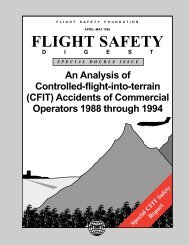
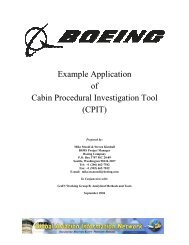
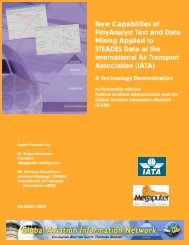


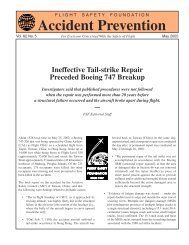
![Download [PDF 8 MB] - Flight Safety Foundation](https://img.yumpu.com/18859366/1/190x245/download-pdf-8-mb-flight-safety-foundation.jpg?quality=85)
